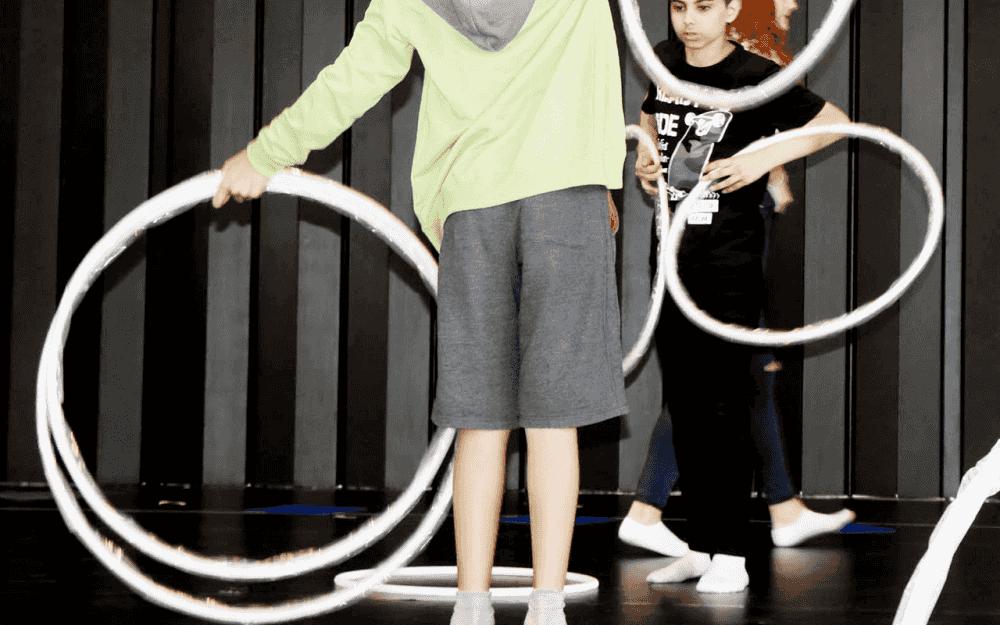Projektraum - Reifentanz

bauhaus agenten Dessau
- Durchführungszeit
- 120 min
- Altersstufe
- 10 – 16 Jahre
- Ort
- drinnen
Welche Stellung hat der Mensch im Raum? Und wie korrespondieren und gestalten sich beide gegenseitig über die Bewegung? Das war das große Thema des Schaffens von Oskar Schlemmer. Der deutsche Maler, Bildhauer und Bühnenbildner war eng mit dem Bauhaus verbunden, er hatte zum Beispiel dessen Logo erschaffen. Schlemmer schwebte stets eine moderne, bildkünstlerische Gestaltung vor. Allerdings empfand er Bewegung in plastischen Werken als einschränkend, denn dort ist die Bewegung quasi »fixiert«. Viel flexibler ist der Tanz als Darstellungsform. Und so schuf Schlemmer zum Beispiel Tänze zu bestimmten Materialien und deren szenischen Möglichkeiten – wie der Reifentanz.
Format
1 Unterrichtseinheit
Fach
Kunst, Sport, Mathematik
Kompetenzen & Vermittlungsziel
Raum- und Körperwahrnehmung, Bewegungsgestaltung, Exploration
Historischer Bezug
An der von Oskar Schlemmer geleiteten experimentellen Bühnenwerkstatt des Bauhauses entstanden die sogenannten »Materialtänze«: etwa Metalltanz, Glastanz, Reifentanz und Kulissentanz – Szenen, in denen Bewegungsabläufe im Spannungsfeld von Körper, Objekten und Raum erprobt wurden. Eine wichtige Rolle spielen hierbei bestimmte Materialien und die Weise, wie diese die Bewegungen beeinflussen. Im »Reifentanz« etwa wird anhand einfacher Holzreifen gezeigt, wie sich aus dem Material Holz und der Form eines Kreises Möglichkeiten zu Bewegungsaktionen und zur Gestaltung des Raumes gewinnen lassen.
Aktualitätsbezug
Die Inszenierung des Raums mit den Mitteln von Tanz, Theater, Ton und Materialien: Heute versteht sich die Bühne unter anderem wieder als einen Schaffensort, an dem Schauspieler, Tänzer, Musiker und andere Künstler gemeinsam experimentelle Projekte entwickeln. So war es auch an der Versuchsbühne des Bauhauses. Dort wollte man mit Theatermitteln den modernen Menschen im Spannungsfeld von Industrialisierung, Mechanisierung und Typisierung einerseits und Emanzipation und Individualität andererseits untersuchen. Nach einige Jahrzehnten Schattendasein hat sich der Geist solche Experimentiertheater seit den 1970er-Jahren wieder fest in der Bühnenlandschaft etabliert.
Technische & räumliche Voraussetzungen
- leere Raumfläche zum freien Bewegen
Autoren
bauhaus agenten Dessau
»Es ist in der Tat wichtig, wie die Dimensionen des Bühnenraumes, Höhe, Tiefe, Breite sich zueinander und zur menschlichen Figur verhalten.«
Oskar Schlemmer, deutscher Maler, Bildhauer und Bühnenbildner, 1926